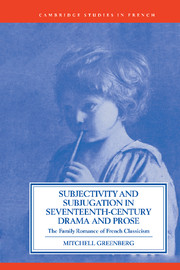 Subjectivity and Subjugation in Seventeenth-Century Drama and Prose
Subjectivity and Subjugation in Seventeenth-Century Drama and Prose Published online by Cambridge University Press: 16 October 2009
Alors, le regard cherche, nous regardons de tous nos yeux dans le seul but de, enfin, ne plus voir, mais être.
Car si le visible ne s'épuise ni en une visée transcendente, ni en une pensée proximale d'un espace partes extra-partes s'il est prégnant de l'invisible, “Voir c'est ne plus être.” … plus on voit, moins on est, plus on est moins on voit.
Unquestionably Le Tartuffe is Molière's most scandalous comedy. From its creation at Versailles as part of the royal festivities known as the “Plaisirs de l'Ile Enchantée” in May of 1664 to its withdrawal from the stage and the royal government's refusal to allow its public performance for a period of several years, the play, in its different versions, ignited a debate rarely paralleled in the annals of the French stage. During the period of its prohibition, Molière, his supporters and enemies engaged in heated controversy over the real or imagined attack on piety and “dévots,” and over the social, moral and ethical role of the theater in society. Until its rehabilitation in 1669, the play, perhaps more than any other of the seventeenth century, generated a dizzying whirlwind of charges and countercharges that clearly situates it as the focal point of an entire epistemological dilemma, of a sensitive, overly charged threat to all social order, to, even (if we listen to the ravings of Pierre Roullé) the invasion of the well-ordered world of ecclesiastical and monarchal order by the “satanic”: Molière was accused of being “un démon vêtu de chair et habillé en homme…”
To save this book to your Kindle, first ensure [email protected] is added to your Approved Personal Document E-mail List under your Personal Document Settings on the Manage Your Content and Devices page of your Amazon account. Then enter the ‘name’ part of your Kindle email address below. Find out more about saving to your Kindle.
Note you can select to save to either the @free.kindle.com or @kindle.com variations. ‘@free.kindle.com’ emails are free but can only be saved to your device when it is connected to wi-fi. ‘@kindle.com’ emails can be delivered even when you are not connected to wi-fi, but note that service fees apply.
Find out more about the Kindle Personal Document Service.
To save content items to your account, please confirm that you agree to abide by our usage policies. If this is the first time you use this feature, you will be asked to authorise Cambridge Core to connect with your account. Find out more about saving content to Dropbox.
To save content items to your account, please confirm that you agree to abide by our usage policies. If this is the first time you use this feature, you will be asked to authorise Cambridge Core to connect with your account. Find out more about saving content to Google Drive.